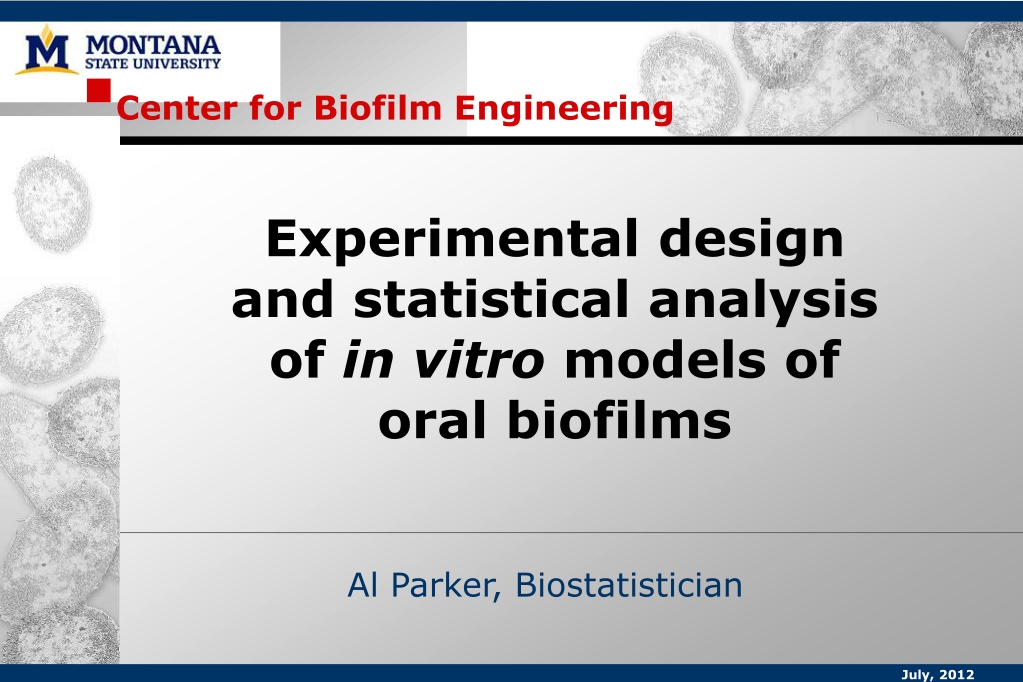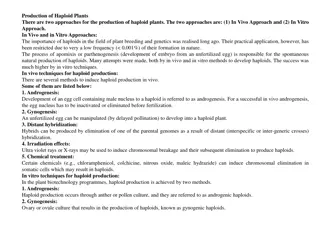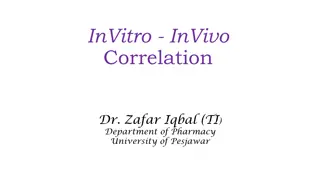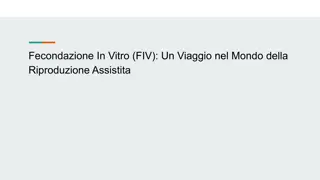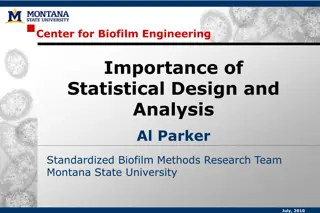Statistical Thinking in In Vitro Biofilm Research
Explore the importance of statistical thinking in in vitro biofilm research, including experimental design, uncertainty assessment, and the attributes of in vitro methods like repeatability and resemblance. Learn how statistical thinking helps anticipate criticism, provide convincing results, increase efficiency, and improve communication in research endeavors.
Download Presentation

Please find below an Image/Link to download the presentation.
The content on the website is provided AS IS for your information and personal use only. It may not be sold, licensed, or shared on other websites without obtaining consent from the author.If you encounter any issues during the download, it is possible that the publisher has removed the file from their server.
You are allowed to download the files provided on this website for personal or commercial use, subject to the condition that they are used lawfully. All files are the property of their respective owners.
The content on the website is provided AS IS for your information and personal use only. It may not be sold, licensed, or shared on other websites without obtaining consent from the author.
E N D
Presentation Transcript
Center for Biofilm Engineering Experimental design and statistical analysis of in vitro models of oral biofilms Al Parker, Biostatistician July, 2012
What is statistical thinking? Data/Response Experimental Design Uncertainty assessment
What is statistical thinking? Data/Response (pixel intensity in an image? log(cfu) from viable plate counts?) Experimental Design - controls - randomization - replication (How many coupons? experiments? technicians? labs?) Uncertainty and variability assessment
Why statistical thinking? Anticipate criticism (design method and experiments accordingly) Provide convincing results (establish statistical properties) Increase efficiency (conduct the least number of experiments) Improve communication
Why statistical thinking? in vitro testing
Attributes of an in vitromethod: Seven Rs Relevance Reasonableness Ruggedness Responsiveness Reproducibility (inter-laboratory) Resemblance Repeatability (intra-laboratory reproducibility) http://www.biofilm.montana.edu/content/ksa-sm-03
Attributes of an in vitromethod: Seven Rs Relevance Reasonableness Ruggedness Responsiveness Reproducibility (inter-laboratory) Resemblance Repeatability (intra-laboratory reproducibility)
Resemblance Independent repeats of the same experiment in the same laboratory produce nearly the same control data, as indicated by a small repeatability standard deviation, CSr = STDEV(Mean Controls for each experiment) http://www.biofilm.montana.edu/content/ksa-sm-10
Resemblance Example ASTM E2647 Drip Flow Reactor Low shear Plug flow
Resemblance Example 4 slides or coupons Experimental Design: saliva collected from volunteers 4 day old supragingival biofilms Both saline and treatment applied for 1 minute 5 independent experimental runs control treated (sterile saline) (Chlorhexidine digluconate 0.12%)
Resemblance Example Data: log10(cfu/cm2) from viable plate counts Density LD Coupon cfu/cm2 1 2.3 x 108 8.36 2 1.7 x 108 8.23 log(cfu/cm2) ControlLD= 8.29
Resemblance Example coupon LD 8.36 8.23 7.62 7.49 7.59 7.78 7.84 8.08 7.77 7.33 Control LD Control SD Exp 1 1 2 2 3 3 4 4 5 5 8.29 0.0871 7.55 0.0910 7.68 0.1376 7.96 0.1660 7.55 0.315
Resemblance from experiment to experiment Summary Statistics: 1. Mean ControlLD = 7.81 the best guess for the true mean control LD log10 (cfu/cm2) 2. CSr=STDEV(ControlLDs) =0.32 the typical distance between the ControlLD for a single experiment and the true mean control LD CSr is not STDEV(LDs)
Resemblance from experiment to experiment The variance CSr2 can be partitioned: log10 (cfu/cm2) 84% due to among experiment sources 16% due to within experiment sources
Estimating the true mean control LD with confidence 1. Start with your best guess: Mean ControlLD 2. Calculate the SE of Mean ControlLD, using: CS2c = within-experiment variance of control coupon LD CS2E = among-experiments variance of control coupon LD nc = number of control coupons per experiment m = number of experiments 2 2 CS CS E c SE of Mean ControlLD = CSr / = + m m nc m 3.CI for the true mean control LD = Mean ControlLD tm-1 x SE
Estimating the true mean control LD with confidence 1. Mean ControlLD = 7.81 2. Calculate the SE of Mean ControlLD: CS2c = 0.16 x (.32)2 = 0.03211 CS2E = 0.84 x (.32)2 = 0.08544 nc = 2 m = 5 0.08544 0.03211 = 0.1425 + SE of Mean ControlLD = 5 2 5 3. A 95% CI for true mean control LD = (7.41, 8.20) = 7.81 2.78 x 0.1425 = 7.81 0.33
Estimating the true mean control LD with confidence We are 95% confident that the true mean of the control LDs is in this interval log10 (cfu/cm2)
Attributes of an in vitromethod: Seven Rs Relevance Reasonableness Ruggedness Responsiveness Reproducibility (inter-laboratory) Resemblance Repeatability (intra-laboratory reproducibility)
Repeatability Independent repeats of the same experiment in the same laboratory produce nearly the same response, as indicated by a small repeatability standard deviation Sr = STDEV(Mean response for each experiment) http://www.biofilm.montana.edu/content/ksa-sm-10
Repeatability Example 4 slides or coupons control treated (saline) (Chlorhexidine digluconate 0.12%)
Repeatability Example Data/Response: log reduction (LR) LR = mean(control LDs) mean(treated LDs)
Repeatability Example coupon LD 8.36 8.23 7.62 7.49 7.59 7.78 7.84 8.08 7.77 7.33 Control LD Control SD Exp 1 1 2 2 3 3 4 4 5 5 8.29 0.0871 7.55 0.0910 7.68 0.1376 7.96 0.1660 7.55 0.315
Repeatability Example control coupon LD 8.36 8.23 7.62 7.49 7.59 7.78 7.84 8.08 7.77 7.33 treated coupon LD 6.60 4.97 5.61 5.47 5.25 5.20 7.37 5.63 7.46 5.87 Control LD Treated LD Exp 1 1 2 2 3 3 4 4 5 5 LR Since there is no obvious pairing between the controls and treated coupons in each experiment, get 1 LR for each experiment 8.29 5.79 2.51 7.55 5.54 2.08 7.68 5.22 2.46 7.96 6.50 1.46 7.55 6.66 0.89 Mean LR = 1.87
Repeatability Example Summary Statistics: 1. Mean LR = 1.87 the best guess for the true mean LR 2. Sr = STDEV(LRs) = 0.69 the typical distance between the LR for a single experiment and the true mean LR
Estimating the true mean LR with confidence 1. Start with your best guess: Mean LR 2. Calculate the SE of Mean LR, using: S2c = within-experiment variance of control coupon LD S2d = within-experiment variance of treated coupon LD S2E = among-experiment variance of LR nc = number of control coupons per experiment nd = number of treated coupons per experiment m = number of experiments 2 2 2 S S S E d c + + SE of mean LR = Sr / = m m nd m nc m 3. CI for the true mean LR = Mean LR tm-1 x SE
Estimating the true mean LR with confidence 1. Mean LR = 1.87 2. Sc2 = 0.03211 Sd2 = 0.82092 SE2 = 0.06219 nc = 2, nd = 2, m = 5 0.06219 0.03211 0.82092 SE of mean LR = = 0.309 + + 5 2 5 2 5 3. 95% CI for true mean LR = 1.87 2.78 x 0.309 = 1.87 0.8580 = (1.01, 2.73)
Estimating the true mean LR with confidence We are 95% confident that the true mean LR is in this interval
How many coupons? experiments? 0.06219 0.03211 0.82092 + + margin of error= tm-1 x m nd m nc m no. control coupons (nc): no. treated coupons (nd): no. experiments (m) 2 3 4 5 10 100 1 1 1 2 2 2 1 3 4 4 1 7 8.49 6.31 6.21 5.39 4.67 4.10 2.35 1.75 1.72 1.49 1.29 1.13 1.50 1.12 1.10 0.96 0.83 0.73 1.17 0.87 0.86 0.75 0.64 0.57 0.68 0.50 0.49 0.43 0.37 0.33 0.19 0.14 0.14 0.12 0.10 0.09
Summary Even though biofilms are complicated, it is feasible to develop in vitromethods that meet the Seven R criteria. Good experiments use controls, randomization where possible, and sufficient replication. Assess uncertainty by reporting CIs. To reduce uncertainty, invest effort in conducting more experiments instead of using more coupons in a single experiment. For additional statistical resources for biofilm methods, check out: http://www.biofilm.montana.edu/category/documents/ksa-sm
